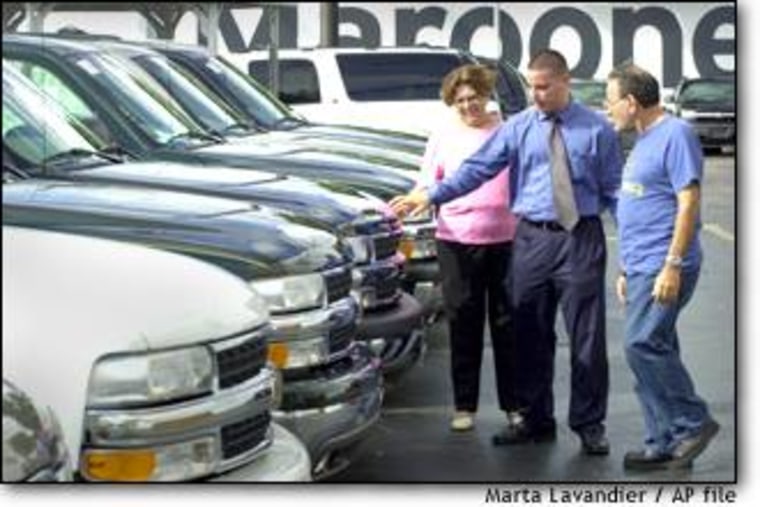Strong car sales helped propel U.S. economic growth of 3.1 percent in the third quarter, the Commerce Department said Thursday in a report that was a bit weaker than expected. Economists say growth is likely to slow significantly in the current quarter, and most now expect the Federal Reserve to lower interest rates next week in an effort to kick-start activity.
Gross domestic product, considered the best barometer of the nation’s health, was slightly under the 3.6 percent rate forecast by analysts, but still far better than the anemic 1.3 percent growth of the second quarter. GDP measures total inflation-adjusted output within U.S. borders and is the broadest gauge of how the nation’s $10 trillion economy is performing.
Strong sales of new cars, driven by a wave of zero-percent financing offers over the summer, were a major contributor to an acceleration in consumer spending, which fuels most of the nation’s economic activity. But car sales slowed in September and October, and businesses have turned extremely cautious in hiring and investment, at least in part because of the looming prospect of war in Iraq, economists say.
“The economy is losing steam,” said Sung Won Sohn, chief economist at Wells Fargo & Co. “As car sales drop, consumer spending will become a bit of a headwind for the economy. Housing has already plateaued. It will weaken from the high plateau.”
He predicted “anemic” growth of 1 percent in the fourth quarter, and few economists expect growth much over 2 percent, well below the Fed’s target rate.
No double-dip
While growth is slowing and the labor market is painfully weak, the vast majority of economists say the nation’s output is continuing to expand and is unlikely to drop back into recession.
The GDP report “continues to suggest there is some forward momentum to the economy,” said John Silvia, chief economist at Wachovia Securities. “This is not a double-dip scenario.”
But he said consumers and businesses are likely to hold tightly to their wallets due to uncertainty over the economy and the potential for war.
“I think the war is already here for the U.S. economy,” he said.
He predicted the Fed will cut short-term interest rates a quarter- or half-point next week, presuming Friday’s employment report is weak as expected. On average analysts expect the government to report that the number of payroll employees was virtually unchanged in October from September, and many expect the jobless rate to rise slightly from the current 5.6 percent rate.
Other, more current economic data published Thursday contributed to expectations for weak growth going forward.
The government said 410,000 people filed new claims for unemployment benefits in the latest week, up from 394,000 the week earlier.
And the Chicago Purchasing Managers index fell to its lowest level since January, reflecting a weak regional manufacturing sector. Some analysts said the figure foreshadows a weak national report Friday from the Institute for Supply Management, a private survey that is closely watched by Fed economists.
Diane Swonk, chief economist at Bank One in Chicago, also predicted a Fed rate cut this week, although she said it would have little impact due to low existing rates and the long lag time for monetary policy changes to work their way through the economy.
“Right now we’ve got a lot of external things that ail us,” she said. “Even though you can say none of those things are interest rate-related, it puts the Fed between a rock and hard place if they are hedging against a further downturn.”
Financial markets now are expecting a rate cut and will be disappointed if the Fed does not act, other analysts said.
Certainly there was some good news in the GDP report, especially an encouraging increase in business spending on equipment and software, which rose 6.5 percent in the quarter after a 3.3 percent gain in the second quarter. “These gains are modest by comparison to the double-digit advances that were typical in the last decade but certainly represent progress in the right direction,” said Jade Zelnick, chief economist at RBS Greenwich Capital.
Increased business spending is considered crucial to continuing the expansion, which has been driven largely by consumer spending.
Spending on “durable” goods — big ticket items, including cars — grew by a whopping 22.7 percent pace in the third quarter, a huge increase from the 2 percent pace posted in the previous quarter. Consumer spending grew at a brisk 4.2 percent pace in the third quarter, up from a tepid 1.8 percent rate in the second quarter. Both overall consumer spending and spending on durables in the third quarter were the strongest since the fourth quarter of last year.
Inflation rate drops
However, businesses continued to slash spending on new factories, office buildings and other structures at a rate of 16 percent in the third quarter, on top of a 17.6 percent rate of decline in the second quarter.
Another factor restraining third quarter GDP was slower inventory building by businesses, which are wary about the economic recovery and watched profits take a hit during the recession. Analysts say that could contribute to growth in the first quarter if businesses discover they need to rebuild inventories, as happened a year ago.
An inflation gauge tied to the GDP showed that inflation is not a problem for the economy, giving the Fed leeway to keep rates low or nudge them down even further. The gauge showed inflation grew at a 1.9 percent rate in the third quarter, down from a 2.7 percent pace in the second.
Top economic forecasters, meanwhile, are growing more pessimistic about this year’s economic outlook.
The National Association for Business Economics in a quarterly poll released Thursday reported that 53 percent of forecasters surveyed said they were “somewhat more pessimistic” about the economy, up from 28 percent in its previous survey in July.
The Associated Press and Reuters contributed to this report.
